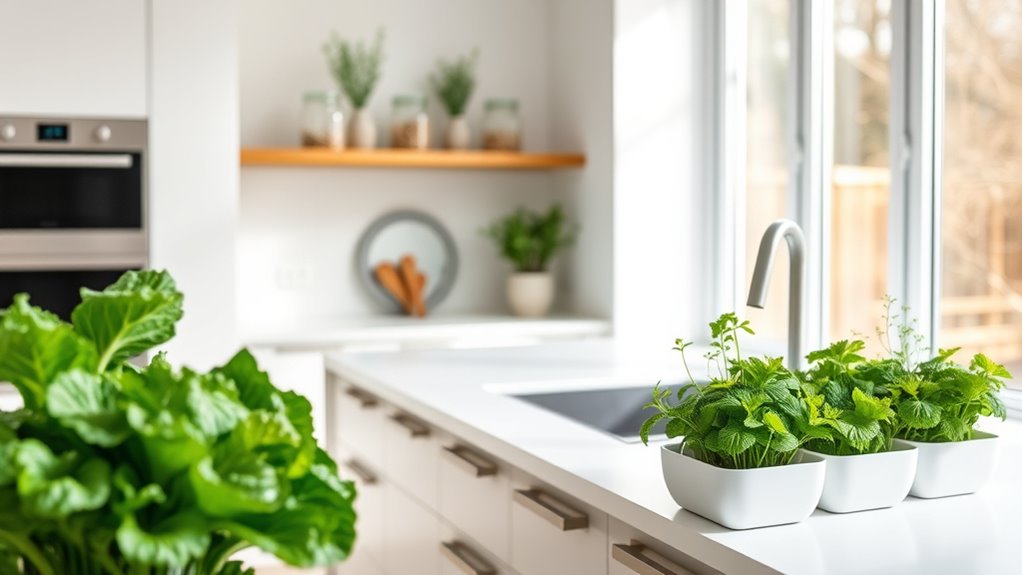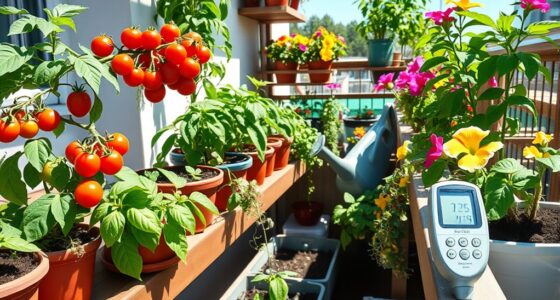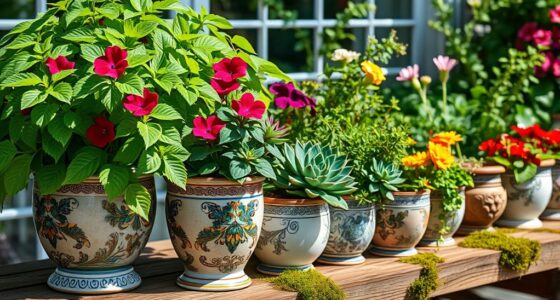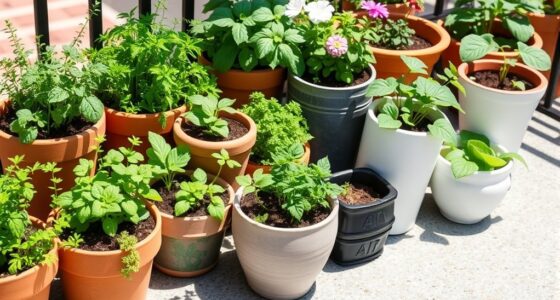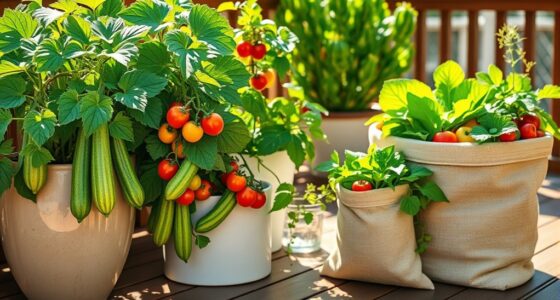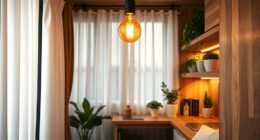Growing your own veggies indoors is easy with hydroponic systems that fit in small spaces. These setups use nutrient-rich water instead of soil, helping you harvest fresh herbs and vegetables all year round. They’re efficient, quick-growing, and control pests better. By managing light, temperature, and cleanliness, you can create an ideal environment for healthy plants without outdoor space. To discover simple tips and setups for indoor gardening, keep exploring how to grow food without a yard.
Key Takeaways
- Indoor hydroponic systems allow growing vegetables like lettuce and herbs without outdoor space.
- They maximize small areas with compact, efficient setups suitable for indoor environments.
- Controlled conditions enhance plant growth, reduce pests, and minimize the need for chemical pesticides.
- Proper lighting, ventilation, and environment management promote healthy, high-yield indoor vegetable production.
- Regular maintenance and natural pest control methods ensure a pest-free, thriving indoor vegetable garden.

Have you ever considered growing fresh vegetables right inside your home? With the rise of indoor gardening, it’s easier than ever to enjoy a garden without needing a yard. One popular method is using hydroponic systems, which allow you to grow plants in nutrient-rich water instead of soil. These systems are compact, efficient, and ideal for indoor spaces, enabling you to cultivate everything from lettuce to herbs in a controlled environment. Hydroponic setups take up less space, reduce mess, and often yield faster growth compared to traditional soil gardening. Plus, since you’re growing indoors, you can easily monitor and adjust light, temperature, and nutrients to optimize plant health.
When managing pests indoors, you face fewer challenges than outdoor gardens, but pest management still requires attention. The confined environment of an indoor garden means pests like aphids, spider mites, or fungus gnats can spread quickly if not controlled early. To prevent infestations, keep your space clean, avoid overwatering, and regularly inspect your plants. Introducing natural pest control methods, such as neem oil or insecticidal soap, can help keep pests at bay without harmful chemicals. Since you’re working in a controlled environment, you have the advantage of acting swiftly if pests appear, reducing the need for chemical pesticides that could harm your indoor air quality or plants.
Growing vegetables indoors with hydroponic systems makes pest management a straightforward process. You can isolate affected plants easily and treat them without risking the health of your entire garden. Additionally, because indoor gardening typically involves less soil, there’s less chance of soil-borne diseases developing. Using sterile, pre-made growing mediums and maintaining proper hygiene further minimizes pest and disease risks. Proper lighting, such as high-quality grow lights**, plays a vital role too; with grow lights, you can simulate ideal sunlight**, encouraging healthy, vigorous growth and helping your plants resist pests naturally. Good ventilation is also key—good airflow prevents humidity buildup that can encourage mold or pests.
Frequently Asked Questions
What Are the Best Lighting Options for Indoor Vegetable Growth?
You want the best lighting options for indoor vegetable growth. LED grow lights are a top choice because they provide energy-efficient, full-spectrum light that promotes healthy plant development. While natural sunlight is ideal, it might not always be available, so supplement with LED grow lights to guarantee your veggies get enough light daily. Combining both can give your plants the perfect environment for thriving indoors.
How Do I Prevent Pests Indoors Without Chemicals?
You want to prevent pests indoors naturally, avoiding chemicals. Focus on natural pest control methods like introducing beneficial insects, using neem oil, and maintaining cleanliness. Regularly inspect your plants for signs of pests, remove affected leaves, and keep your growing space tidy. To guarantee indoor pest prevention, keep humidity low, improve airflow, and avoid overwatering. With consistent care, you create a healthy environment where pests struggle to thrive.
What Is the Optimal Humidity Level for Indoor Veggies?
You should aim for a humidity level around 50-70% for ideal moisture control when growing indoor veggies. Maintaining proper humidity helps prevent issues like mold or pests while ensuring your plants stay healthy. Use a hygrometer to monitor moisture levels regularly, and adjust humidity with a humidifier or dehumidifier as needed. Consistent humidity control promotes strong growth and bountiful harvests indoors.
How Often Should Indoor Vegetable Plants Be Watered?
You should water your indoor vegetable plants when their soil feels dry about an inch below the surface. This watering frequency guarantees proper plant hydration without overwatering. Typically, you’ll need to water once or twice a week, but it depends on your indoor environment’s humidity and temperature. Keep an eye on your plants; if leaves start to wilt or yellow, it’s a sign they need more water.
Can I Grow Root Vegetables Indoors Successfully?
Imagine opening a hidden treasure right in your living room. Growing root vegetables indoors is definitely possible with container gardening. You’ll want to choose the right container and soil selection that drains well and provides enough space for roots to expand. Regular watering and proper lighting help. With patience and care, you can harvest fresh carrots, beets, or radishes right from your indoor space, turning your home into a mini farm.
Conclusion
Growing your own veggies indoors is easier than you think, even if you don’t have a yard. Sure, some worry about limited space or lack of sunlight, but with the right containers and grow lights, you can flourish. Just start small, stay consistent, and enjoy fresh, homegrown produce year-round. Don’t let space or sunlight hold you back—your indoor garden can be as vibrant and bountiful as any outdoor plot.
